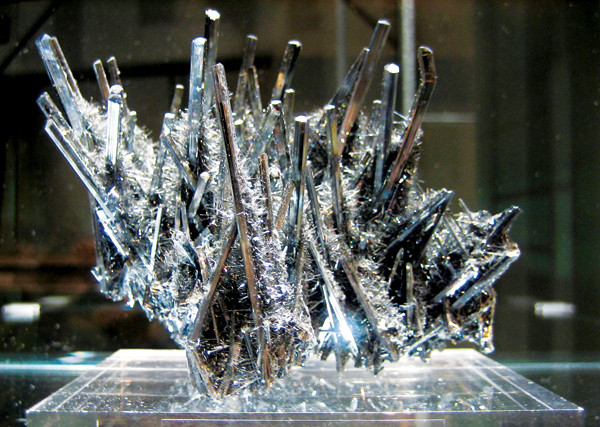
by U.S. Geological Survey Monday, January 5, 2015
David Guberman, the antimony commodity specialist for the National Minerals Information Center at the U.S. Geological Survey, compiled the following information about antimony, widely used in alloys and in flame retardants.

Stibnite is a principal ore of antimony. Credit: PepperedJane.
Antimony is a lustrous silvery-white semimetal or metalloid. Archaeological and historical studies indicate that antimony and its mineral sulfides have been used by humans for at least six millennia. The alchemist Basil Valentine is sometimes credited with “discovering” the element; he described the extraction of metallic antimony from stibnite in his treatise “The Triumphal Chariot of Antimony,” published sometime between 1350 and 1600. In the early 18th century, Jöns Jakob Berzelius chose the periodic symbol for antimony (Sb) based on stibium, which is the Latin name for stibnite.
Antimony is nonmalleable, hard and brittle and can be crushed to a powder. Compared with metals, antimony is a poor conductor of electricity and heat. Antimony is the 63rd-most abundant element in Earth’s crust. It is less abundant than tin, arsenic and the rare earths, but more so than bismuth, mercury and silver. Antimony tends to concentrate in sulfide ores along with copper, lead and silver. It occurs sparingly as a free element, but when it does it is usually in association with arsenic, bismuth or silver.
The principal ore minerals of antimony are stibnite and jamesonite, but it can also be a byproduct of certain other minerals. Eighty percent of the world’s antimony is produced from two types of deposits — carbonate replacement deposits and gold-antimony epithermal deposits.
The majority of antimony is consumed in the production of antimony trioxide (ATO), a compound used in flame-retardant materials. Combined with halogenated particles, ATO suppresses, reduces or delays the spread of flame. It is incorporated into adhesives, paints, plastics, rubber insulation, decorative foams, building materials and textiles, including upholstered furniture.
No marketable antimony has been mined in the United States since 2001, when the Sunshine Silver Mine in Idaho, which produced antimony as a byproduct, closed. The U.S. relies heavily on imports from China, which dominates global mine production of antimony ores and concentrates and which restricts the amount of antimony produced and exported annually.
As of 2014, several new sources of domestic antimony were in different stages of development. One company began mining stibnite ore for upgrade and sale at a restarted antimony mine in Nevada, and was in the process of acquiring a mill to process the ore and produce marketable antimony concentrate. There was also interest in exploring and mining the historic Yellow Pine Mine, a gold-antimony deposit in central Idaho, that produced antimony from the 1990s to 2001.
For more information on antimony and other mineral resources, visit: http://minerals.usgs.gov/minerals/.
In 2013, China was the leading global producer, accounting for about 78 percent of world mine production, followed by Burma (6 percent), Russia (5 percent), Bolivia (3 percent) and Tajikistan (3 percent).
China was also the leading consumer of antimony in 2013, followed by the United States and Japan.
More than 50 percent of the antimony consumed globally is thought to be used in flame retardants.
The name antimony was derived from the Greek words, “anti,” meaning not, and “monos,” meaning alone, because antimony is normally found in complex ore bodies.
In ancient times, powdered stibnite was, along with lead sulfide, a principal ingredient of kohl, the thick black paste used by the Egyptians and others as a cosmetic for coloring eyebrows and lining the eyes.
In the Middle Ages, antimony was used as a “recyclable” laxative. It was swallowed in the form of a pea-sized pill and could be reused after passing through the digestive system.
Antimony is added to fireworks to create glitter effects.
© 2008-2021. All rights reserved. Any copying, redistribution or retransmission of any of the contents of this service without the expressed written permission of the American Geosciences Institute is expressly prohibited. Click here for all copyright requests.